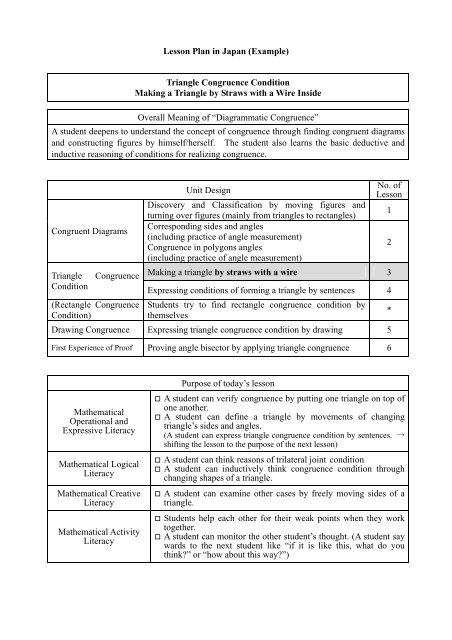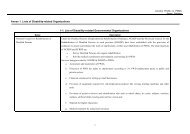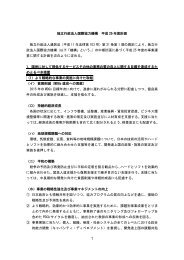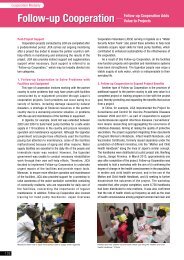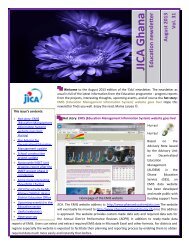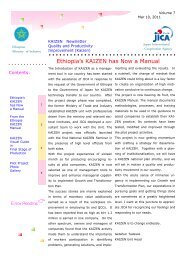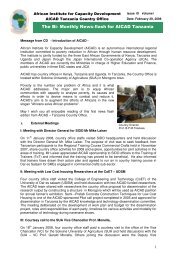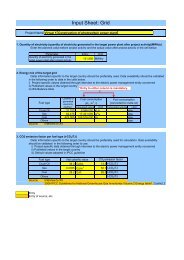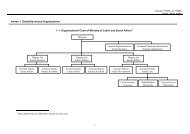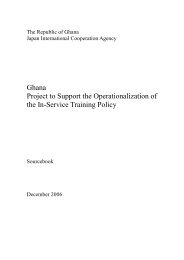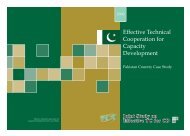Lesson Plan in Japan (Example) Triangle Congruence ... - JICA
Lesson Plan in Japan (Example) Triangle Congruence ... - JICA
Lesson Plan in Japan (Example) Triangle Congruence ... - JICA
You also want an ePaper? Increase the reach of your titles
YUMPU automatically turns print PDFs into web optimized ePapers that Google loves.
<strong>Lesson</strong> <strong>Plan</strong> <strong>in</strong> <strong>Japan</strong> (<strong>Example</strong>)<br />
<strong>Triangle</strong> <strong>Congruence</strong> Condition<br />
Mak<strong>in</strong>g a <strong>Triangle</strong> by Straws with a Wire Inside<br />
Overall Mean<strong>in</strong>g of “Diagrammatic <strong>Congruence</strong>”<br />
A student deepens to understand the concept of congruence through f<strong>in</strong>d<strong>in</strong>g congruent diagrams<br />
and construct<strong>in</strong>g figures by himself/herself. The student also learns the basic deductive and<br />
<strong>in</strong>ductive reason<strong>in</strong>g of conditions for realiz<strong>in</strong>g congruence.<br />
Unit Design<br />
No. of<br />
<strong>Lesson</strong><br />
Discovery and Classification by mov<strong>in</strong>g figures and<br />
turn<strong>in</strong>g over figures (ma<strong>in</strong>ly from triangles to rectangles)<br />
1<br />
Correspond<strong>in</strong>g sides and angles<br />
Congruent Diagrams<br />
(<strong>in</strong>clud<strong>in</strong>g practice of angle measurement)<br />
2<br />
<strong>Congruence</strong> <strong>in</strong> polygons angles<br />
(<strong>in</strong>clud<strong>in</strong>g practice of angle measurement)<br />
<strong>Triangle</strong> <strong>Congruence</strong> Mak<strong>in</strong>g a triangle by straws with a wire 3<br />
Condition<br />
Express<strong>in</strong>g conditions of form<strong>in</strong>g a triangle by sentences 4<br />
(Rectangle <strong>Congruence</strong> Students try to f<strong>in</strong>d rectangle congruence condition by<br />
Condition)<br />
themselves<br />
*<br />
Draw<strong>in</strong>g <strong>Congruence</strong> Express<strong>in</strong>g triangle congruence condition by draw<strong>in</strong>g 5<br />
First Experience of Proof Prov<strong>in</strong>g angle bisector by apply<strong>in</strong>g triangle congruence 6<br />
Mathematical<br />
Operational and<br />
Expressive Literacy<br />
Mathematical Logical<br />
Literacy<br />
Mathematical Creative<br />
Literacy<br />
Mathematical Activity<br />
Literacy<br />
Purpose of today’s lesson<br />
A student can verify congruence by putt<strong>in</strong>g one triangle on top of<br />
one another.<br />
A student can def<strong>in</strong>e a triangle by movements of chang<strong>in</strong>g<br />
triangle’s sides and angles.<br />
(A student can express triangle congruence condition by sentences. →<br />
shift<strong>in</strong>g the lesson to the purpose of the next lesson)<br />
A student can th<strong>in</strong>k reasons of trilateral jo<strong>in</strong>tcondition<br />
A student can <strong>in</strong>ductively th<strong>in</strong>k congruence condition through<br />
chang<strong>in</strong>g shapes of a triangle.<br />
A student can exam<strong>in</strong>e other cases by freely mov<strong>in</strong>g sides of a<br />
triangle.<br />
Students help each other for their weak po<strong>in</strong>ts when they work<br />
together.<br />
A student can monitor the other student’s thought. (A student say<br />
wards to the next student like “if it is like this, what do you<br />
th<strong>in</strong>k?” or “how about this way?”)
Preparation of today’s lesson<br />
Basically student’s activities can be done <strong>in</strong> a group of 4 students (2 students/group can also<br />
be considered)<br />
Prepar<strong>in</strong>g straws, wires and other tools: str<strong>in</strong>gs, rubber bands, angles made by cardboard,<br />
scissors, and cellulose tapes (See Appendix 1).<br />
Activity Flow<br />
Anticipated students’<br />
Reactions<br />
What to support, what to<br />
evaluate<br />
A teacher expla<strong>in</strong>s about the activity <strong>in</strong> the lesson. The teacher says, “Today,<br />
you will make various k<strong>in</strong>ds of triangles by us<strong>in</strong>g straws and wires. Then, you<br />
will exam<strong>in</strong>e whether these triangle are congruent or not.”<br />
Time<br />
0-2<br />
m<strong>in</strong><br />
Step 1: The teacher<br />
distributes 3 straws and a<br />
str<strong>in</strong>g to each student (one<br />
set/student)<br />
The teacher says, “Let the<br />
str<strong>in</strong>g through the 3 straws.<br />
Then, make a triangle by<br />
connect<strong>in</strong>g the end to end<br />
of str<strong>in</strong>g. Is your triangle is<br />
congruent to your next<br />
person’s triangle?” (They<br />
should be congruent.)<br />
Some students cannot<br />
make it and get<br />
confused.<br />
Some students can verify<br />
congruence, but some<br />
other students cannot do<br />
that.<br />
Group members can help<br />
each other if the activity<br />
is simple work.<br />
[Activity]<br />
The teacher makes<br />
students rem<strong>in</strong>d that<br />
congruence can be<br />
verified by putt<strong>in</strong>g one<br />
on top of the other or<br />
check<strong>in</strong>g correspond<strong>in</strong>g<br />
sides and angles.<br />
[Operation]<br />
2-15<br />
m<strong>in</strong><br />
The teacher says, “Please<br />
untie the str<strong>in</strong>g. Then,<br />
replace the 3 straws, put the<br />
str<strong>in</strong>g through the 3 straws<br />
and connect the str<strong>in</strong>g<br />
aga<strong>in</strong>. Can you make any<br />
triangles which are<br />
different from your next<br />
person’s triangle?” (They<br />
cannot do it)<br />
Students somehow try to<br />
make different triangles.<br />
Some students can<br />
realize that it is<br />
impossible to do that.<br />
The teacher facilitates<br />
students to ask questions<br />
to the students who<br />
realized that it is<br />
impossible to do that.<br />
[Logic and Activity]<br />
15-23<br />
m<strong>in</strong><br />
Step 2: The teacher says<br />
“This time, you are mak<strong>in</strong>g<br />
a triangle by straws with a<br />
wire. Please put the white<br />
side on the l<strong>in</strong>e <strong>in</strong> Figure 1<br />
of the work sheet. Next, put<br />
the red side along with<br />
angle on the Figure 1.<br />
Then, put the black side<br />
touch<strong>in</strong>g the edge of the red<br />
side. Fix the edges of black<br />
and red straws by cellulose<br />
tape. After this, please<br />
verify congruence with<br />
Some students do not<br />
<strong>in</strong>stantly understand the<br />
teacher’s <strong>in</strong>struction.<br />
Some students put red<br />
and black sides together<br />
<strong>in</strong>stead of putt<strong>in</strong>g the red<br />
side along with the<br />
angle.<br />
Some students can<br />
quickly complete the<br />
work without difficulties.<br />
The teacher make a<br />
student confirm the<br />
teacher’s <strong>in</strong>struction by<br />
discuss<strong>in</strong>g it with the<br />
next student or the<br />
group. [Activity]<br />
A student can realize<br />
when he/she confirms it<br />
with the next student.<br />
[Operation]<br />
The teacher let students<br />
th<strong>in</strong>k about other angles<br />
<strong>in</strong> the triangle.<br />
[Creativity]<br />
23-33<br />
m<strong>in</strong>
your next person.”<br />
Step3: The teacher says<br />
“Next, you will put the<br />
white side on the l<strong>in</strong>e <strong>in</strong><br />
Figure 2 of the work sheet.<br />
Then put the red side and<br />
black side along with the<br />
angles on Figure 2. What<br />
shape of triangle is it?<br />
Please compare your<br />
triangle to your next<br />
person’s triangle.”<br />
Some students cannot<br />
understand to cross the<br />
red side and the black<br />
side.<br />
Some students can<br />
quickly complete the<br />
work without difficulties.<br />
The teacher let a student<br />
work with the next<br />
student together.<br />
[Activity]<br />
The teacher makes<br />
students th<strong>in</strong>k other<br />
angles of the red and the<br />
black side.<br />
The teacher asks “Are<br />
there angles which make<br />
the edge of red side and<br />
the edge of the black<br />
side just touch<strong>in</strong>g<br />
together?” [Operation]<br />
[Logic] [Creativity]<br />
33-40<br />
m<strong>in</strong><br />
The teacher says, “Please<br />
write your discovery of<br />
rules or orders. You may<br />
discuss it with your group<br />
members when you write<br />
down.”<br />
Some students cannot<br />
write down.<br />
Some students cannot<br />
discuss.<br />
Some students can write<br />
much and discuss well.<br />
The teacher <strong>in</strong>forms<br />
students that it is very<br />
f<strong>in</strong>e to touch and operate<br />
the triangle aga<strong>in</strong>.<br />
The teacher makes<br />
students express their<br />
though on the teach<strong>in</strong>g<br />
materials. [Operation]<br />
[Creativity]<br />
40-50<br />
m<strong>in</strong>
Appendix 1 Activity<br />
Step 1 Result of work Step 2 Figure 1 Step 3 Figure 2<br />
Appendix 2 Dist<strong>in</strong>guish<strong>in</strong>g Characteristics of this Unit<br />
1.1. What is the mean<strong>in</strong>g of learn<strong>in</strong>g triangle congruence condition <strong>in</strong> the junior secondary<br />
education?<br />
<br />
<br />
<br />
Start<strong>in</strong>g Po<strong>in</strong>t of <strong>Plan</strong>e (two dimensions) geometry: Characters of triangle learnt <strong>in</strong> this<br />
unit is the basis for study of all plane geometry.<br />
Introduction to Logic: This unit is the entrance of the world of mathematical proof, that<br />
is to say “Hypothesis and Conclusion”.<br />
Master<strong>in</strong>g Basis of Draw<strong>in</strong>g Figures: Students grow accustomed to us<strong>in</strong>g rulers and a<br />
pair of compasses.<br />
1.2. Students’ difficulties<br />
Students may face many difficulties because this unit has the three elements mentioned above.<br />
Even each element can be difficult for many students.<br />
Students have difficulties on the words of “Sides” and “Angles” when they expla<strong>in</strong> and<br />
listen to.<br />
Students have difficulties to imag<strong>in</strong>e that the triangle congruence condition applies any<br />
k<strong>in</strong>ds of triangles.<br />
Many students cannot handle rulers and a pair of compasses well.


